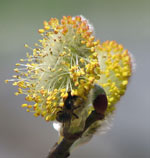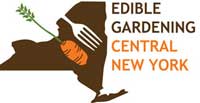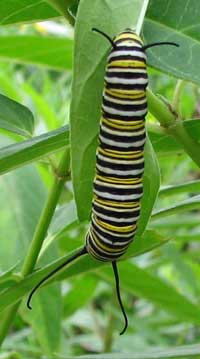Save the date
|
 | | Pussy willow flower (Salix discolor) |
|
The 5th Annual Ithaca Native Landscape Symposium will be held on
March 1 & 2
|
| Living greener together |  | |
Living Green, Living Good in CNY (www.lglgcny.org) is sponsoring the Northwest Earth Institute's discussion course A World of Health: Connecting People, Place, and Planet. (Here's more information about this course.)
We'll meet once a week for seven weeks (exact dates TBA). OCPL has purchased a set of course books that can be checked out, so participation is free for the first 8 people who register.
If you're interested
in learning more about participating, contact Janet Allen.
|
| Master Gardener training |
 | Carolina rose
(Rosa carolina) |
|
Cornell Cooperative Extension (CCE) of Onondaga is accepting applications for their 2013 Master Gardener Volunteer program. Master Gardeners are trained in all areas of horticulture and support the efforts of Cornell University's Horticulture Program.
Applicants must display a passion for gardening and a willingness to work for gardening education in the community. Training classes are Tues. evenings, 6:30 to 9:00pm, Feb. 12 through June 11, with occasional Sat. field trips. The class fee is $175 and trainees must pass a qualifying test at the end of training to become a Master Gardener apprentice. A Master Gardener Apprentice must complete 200 hours of volunteer work, a minimum of 50 hours per year, to become a Master Gardener. The application deadline is January 28. Contact Fran Lawlor, Horticulture Educator, for more information, 315-424-9485 ext 236 or email. Applications can be downloaded directly from the CCE Onondaga website.
|
HGCNY Officers
| President:
Janet Allen
Vice-President:
Carol Biesemeyer
Treasurer:
Randi Starmer
Secretary:
Soule Leiter
Membership:
Linda Rossiter
Program Chair:
Carol Biesemeyer
Newsletter Editor:
Janet Allen
Additional Planning Committee Members:
Beth Mitchell
Dave Mitchell
Peter Huntington
John Allen
Thank you to Peter Huntington for his years of service as Secretary!
|
| Our Habitat Garden |  |
Visit Our Habitat Garden website for information on providing habitat, earth-friendly gardening practices, plants, and various creatures here in Central New York.
|
| HGCNY on Facebook |
As as more of us participate on our Facebook page, this will become a useful resource for asking (and answering!) local HGCNYers' questions about habitat gardening. |
|
Join HGCNY!
|  |
Becoming an official member of HGCNY is easy: just join Wild Ones! Basic household membership is $37/year, but there are other options, too. (See membership application or website.)
Wild Ones
P.O. Box 1274
Appleton, Wisconsin 54912-1274
Make checks payable to Wild Ones.
Or telephone toll-free 877-394-9453.
|
|
Our Edible Garden
|  | Visit OurEdibleGarden.org to see an example of a Central New York edible garden, the perfect companion to your habitat garden.
|
| Interested in Edible Gardening? | 
|
If you'd like to get information on Edible Gardening CNY, just email John to find out about edible gardening tours and monthly programs. Free and open to the public! |
|
Greetings!
 | Joe-pye (Eupatorium),
a native beauty |
If you haven't already started to create a habitat garden using native plants, 2013 is a good year to start. But how do you get started? Our January program will help! Kate Woodle, founder of the habitat garden at the Rosamund Gifford Zoo, will present a beginner-friendly introduction to native plant gardening. When: Sunday, January 27 at 2:00 pm Where: Liverpool Library ( Directions) Free and open to the publicJanet Allen President, HGCNY |
|
|
CNY prepares for the emerald ash borer
 | EAB trap that determines the extent of the invasion
Photo: Bob the Wikipedian
|
From a WRVO report, Jan. 10, 2013It's only a matter of time before the ash tree population in central New York is decimated by the Emerald Ash Borer (EAB). A task force is at work getting ready for the invasion of the deadly insects, that are now in massive numbers only two counties away from Onondaga County. Listen to or read the whole piece...From Cornell Cooperative Extension
* Less than 1% of New York's forests are infested with EAB. Plan now.
* The Emerald Ash Borer puts all of New York's 900 MILLION ash trees at risk.
* Black and green ash are keystone species in wetland ecosystems. Their loss could mean the loss of a whole ecosystem.
* In New York State's hardwood forests 1 in every 10 trees is an ash. From emeraldashborer.info, an international effort to provide information about this pest * It attacks only ash trees (Fraxinus spp.).
* Adult beetles are metallic green and about 1/2-inch long.
* Adults leave a D-shaped exit hole in the bark when they emerge in spring.
* Woodpeckers like EAB larvae; heavy woodpecker damage on ash trees may be a sign of infestation.
* Firewood cannot be moved in New York (as well as in many other states) because of the EAB quarantine.
* It probably came from Asia in wood packing material.
Learn more:
* Cornell Cooperative Extension Invasive Species
* Information for homeowners from EABinfo
|
|
Milkweeds and monarchs: Some nuances
 | | Monarch caterpillar eating a swamp milkweed leaf |
By now, most people know that monarchs need milkweed. No milkweed, no monarchs! It's the only thing that monarch caterpillars can eat.
BUT that's not the whole story. Chemicals in the milkweed (cardenolides) make monarchs toxic and bitter-tasting, and so they protect them from predators. But milkweeds also present dangers to the monarch caterpillar.
Different species of milkweeds contain different amounts of these chemicals, and there's even variation in the amounts within a species.
Some interesting research findings:
* Milkweed's milky latex can gum up the mandibles of small larvae so that they can no longer eat.
* The survival of early instars (i.e. early stages of caterpillar's growth) is lower on plants with high cardenolide levels, and female monarchs prefer to lay eggs on plants with moderate levels of the chemical.
* Small caterpillars use a 'trenching' behavior, in which they chew a small circle through the surface of the leaf, making a circular area to which latex does not flow. Larger caterpillars cut through the mid-vein of a leaf, cutting off latex flow to the entire leaf. These behaviors help protect them from the sticky latex, and possibly also from the toxins, which are more concentrated in the latex.
Monarchs need milkweed
Despite these dangers, monarch must have milkweed! No milkweed, no monarchs! So please plan to plant more milkweeds this year.
Read more...
|
|
Good for the soul

Professors Rachel and Stephen Kaplan of the University of Michigan were among the first academics to study the psychological benefits of nature.
They and others have shown that natural settings such as trees, grass, gardens, and the like, have a profound, positive impact on both mental and physical health.
Some of the findings:
* The psychological health of cancer patients "improved dramatically" after participating in activities such as gardening or walking in the woods.
* The single most powerful factor in avoiding burnout among AIDS caregivers was "locomotion in nature" such as walking, running, biking, or canoeing. (And the quickest route to burnout was watching television.)
Hard vs. soft fascination The Kaplans refer to activities like watching TV or sporting events as "hard fascination." The stimuli are loud, bright, and commanding, and they don't allow for mental rest. "Soft fascination" is the stimulation one finds on a stroll along the beach or in the woods. "Nothing overwhelms the attention," says Stephen, "and the beauty provides pleasure that complements the gentle stimulation." The brain can soak up pleasing images, but it can also wander, reflect, and recuperate. Woodlands, lakes, and other parts of the natural world all restore the soul, but the Kaplans found that one of the most critical factors was that nature was found nearby.
As in walking out our back door into our own natural landscapes perhaps?
Read more ... |
|
Recipe for insect outbreaks
 | | Adirondack forest |
From Bringing Nature Home by Doug Tallamy:
In an effort to create gardens free of insect problems, most gardeners have used a recipe perfect for cooking up insect outbreaks: alien plants, lack of plant diversity, insecticides.
Would we not better achieve our goal of a pest-free garden if we employed nature herself to look after things?
We have spent the last half-century proving beyond the shadow of a doubt that a sterile garden does not work. It is a high-input enterprise requiring more time and money than most of us would like, or are able, to devote or spend.
...(w)e can walk into the woods, look around, decide that things seem to be working pretty well there, and then do our best to recreate a suburban ecosystem that is complex enough to keep itself going without micromanagement on our part.
~ Douglas Tallamy
Bringing Nature Home, 2nd edition; pp. 104-106
|
|
|
|
|